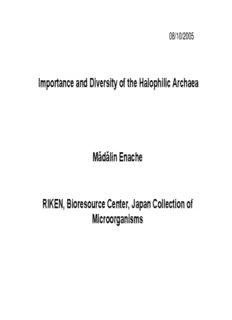
Importance and Diversity of the Halophilic Archaea Mălin Enache PDF
Preview Importance and Diversity of the Halophilic Archaea Mălin Enache
08/10/2005 Importance and Diversity of the Halophilic Archaea Mădălin Enache RIKEN, Bioresource Center, Japan Collection of Microorganisms Introduction in Microbiology Hypersaline environments & halophilic microorganisms Physiological & biochemical properties How they obtaining energy for growth? Particularity of Halophilic Microorganisms - lipids - bacteriorhodopsine How survive microorganisms to high salt concentration? - salt-in strategy -compatible solute strategy Research activity in Japan Living organisms are composed of cells. Plants and animals are called multicellular; they are composed of many cells and each cell depend on the other, cannot have an independent existence Microorganisms are free-living cells. They are unicellular and able to carry out its life processes of growth, energy generation, and reproduction independently of other cells. Microorganisms – a microscopic organism consisting of a single cell. Individually they can be see only by microscope Microbiology – is the study of microorganisms Microbiology study is important as: - basic biological science – understanding life process - applied biological science – industrial process of biotechnology Wide spread of biotechnology is based on diversity of microorganism which can be find in all three domain of life : Hypersaline environments & halophilic microorganisms Categories of halophilic microorganisms Category Growth salt range (M) Example Halotolerant 0.0 - 5.2 Staphylococcus aureus Slight halophile 0.2 - 0.5 Marine bacteria Moderate halophile 0.5 - 2.5 Vibrio costicola Borderline extreme halophile 1.5 - 4.0 Actinopolyspora halophila Extreme halophile >2.5 Halobacterium, Halococcus (After Ventosa A., 1989) Habitat of the halophilic archaea Type of habitat Examples Salterns Alicante, Spain Solar salt Puerto Rico, Bonaire High salt foods Salt fish Salt mines Cheshire, UK Salt lakes, neutral pH Great Salt Lake, Utah Dead Sea, Israel Salt lakes, alkaline pH Lake Magadi, Kenya Owens Lake, California Salt lakes, cold Vestfold Hills, Antarctica Salt ponds Widely distributed (after Norton, C.F., 1992) Aerial view of a modern solar saltern facility in Grantsville, Utah (DasSarma 1995) The Salt Mountain in Slanic Prahova – Romania; The mountain cover partially the Lake Bride Cave, a habitat of new extremely halophilic archaea pertaining to Haloferax and Haloarcula genera Physiological & biochemical properties How they obtaining energy for growth?
Description: